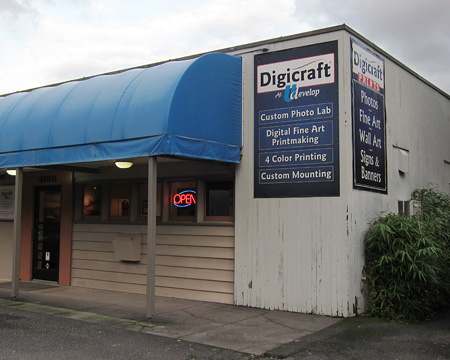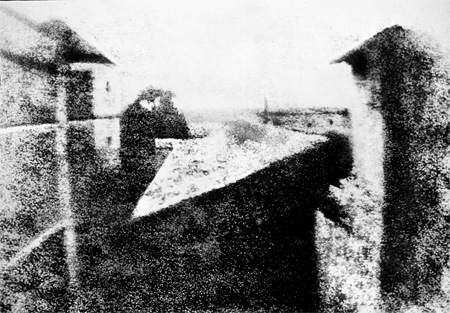







This is an archived article. Click here to return to the blog's home page.
U-Develop Closes: The Decline of Photographic Printing and Why Paper Prints Matter

The end of an era; Digicraft closes its
doors.
Sadly, the preferred lab I've used for printing since 2000, Udevelop/Digicraft in Portland, Oregon closed its doors on December 23, 2014. I've worked with them over those years and together we navigated the transition from traditional darkroom enlargements to digital optical printing on photographic paper. But the handwriting has been on the wall for several years now that there is a shakeout of fine-art print shops in progress. They weren't the first lab to close, nor will they be the last. But the world lost a great resource for making and seeing the beauty of art photography.
The first photographic prints date from around 1826. Here's one:

World's earliest surviving camera photograph, 1826 or 1827:
View from the Window at Le Gras (Saint-Loup-de-Varennes, France) by Joseph
Nicéphore Niépce. From the Wikipedia article History
of Photography.
While it's not much to look at by today's standards, the print shows us a window to a world almost two centuries ago. Predating photography, there are drawings surviving from around 1437 and manuscripts that date from the sixth century A.D. Reproduction of images has taken well over a century to move from hand drawings to a variety of printing technologies. In just a couple of decades there has been an explosion of change owing to digital capture and the Internet. It is clear that printing is now in decline.
In this rapidly evolving marketplace, photographers have a few options. One is to print at home using inkjet printing. Another is to use one of the remaining fine-art labs. I have chosen West Coast Imaging in California as they've printed my work before with excellent service and results. But my prices and delivery time will increase owing to the extra shipping involved to use them. A third option is to go completely online and sell images to clients directly for viewing on wall-mounted displays, or on digital media such as Blu-ray disks.
There's no way to stop this inexorable tide, but I must at least question it so people can make intelligent choices about where it's going. We don't have to do what others are doing, though resisting change will carry its own costs. Here is why I still believe paper prints matter.
Screens let us search for and look at images quickly, and change them at our whim. But there are things they don't do well. They don't often let us look at the image at the detail the photographer intended, as nearly every online photo is compressed. If a photographer allows you to zoom in to see more detail, the experience is different from looking at a print on the wall, as one can only see a crop of the zoomed area defined by the borders of the screen. That's not the same to the eye as being able to wander through an image hanging on the wall by simply moving one's eyes and head. Getting lost in a large print is a visceral feeling photographers strive for, and it's not possible electronically. Even the most expensive large displays cannot approach the pixel count of a large fine-art print.
Screens also draw power. A framed print needs light sometimes, but not if viewed in daylight. So we are moving to an era that's contrary to the need of society to reduce carbon emissions. It will take more electricity to view photography as printed art declines.
Viewing an image on a screen takes away the photographer's freedom to choose the medium on which to present the image. With paper, the artist can choose the surface texture and color gamut of the ink or dyes on the paper or the emulsion. The image is exactly as the photographer wanted it to be seen. On a screen, the image's colors will depend on the quality and gamut of the viewer's display and how accurate the color calibration is. There will likely be color inaccuracies, especially in the highlights and shadows. Even with black-and-white images, these factors apply and can even be more apparent in some cases. Since I likely won't know the exact characteristics of the viewer's display, I can't produce an image that looks best on it.
Unlike a framed print, a digital image is tied in some way to the display system. Display technology is changing rapidly, so an image produced for a display in use today will look very different on a display in use in ten or fifty years from now. Owning an electronic image means buying into an upgrade path to have an image to look at on future technologies. That may mean extra money for photographers, but also more risk for buyers. Think about how quickly digital TV has changed since the first sets came out in 2009 in the US.
Pixels on a display are a periodic arrangement of small red, green, and blue bars. They are not the same as the continuous tones of a photographic print, nor are they the same as the ink dots of an inkjet print. I've written about this topic here. For the viewer, there is a richness and tactile quality of a print that displays cannot match. It's similar to the difference between digital and analog music recordings. Not everyone appreciates or sees the difference, but those that do know what I'm talking about. Images on a screen have an artificial quality that can become readily apparent under certain conditions, such as when there are textures or repeating patterns (called moiré) or areas of high contrast with fine detail.
Another serious problem is protecting the rights of the photographer. Most photographers are reluctant to convert a high-resolution image to electronic form and distribute it widely, because it can be easily duplicated. If electronic distribution becomes the only practical way to sell images, they will be pirated and the pictures essentially become free to anyone willing to violate copyright law. We've seen this play out in the music industry. An album track is usually available for download at 99 cents. Most musicians find that this price is too low to make an honest living unless one is at the top of the charts. Once something is only worth 99 cents, it also becomes difficult to pursue copyright violators. Is it worth going after someone who steals something that's worth only a dollar? Nearly every music track can be found online as a pirated version for free.
A characteristic of prints is that once purchased, they are always there for the owner unless some disaster occurs. Digital images are only there when the viewing medium is turned on and the storage media are working properly. As time passes, there is no real guarantee the images will still be there for the owner. Can you find anything on your computer you bought 25 years ago? Maybe, but not very likely.
All of us need to think carefully about the art we appreciate as the digital revolution progresses. Paper art has real power. It's been around for centuries, and deserves to be around for centuries more. That will only happen if art buyers support the people who make prints. Electronic images have their place and their advantages, but they do not supplant a well-crafted framed image.
